
In military organizations, a colour guard is a detachment of soldiers assigned to the protection of regimental colours and the national flag. This duty is so prestigious that the military colour is generally carried by a young officer (Ensign), while experienced non-commissioned officers are assigned to the protection of the national flag. These NCOs, accompanied sometimes by warrant officers, can be ceremonially armed with either sabres or rifles to protect the colour. Colour guards are generally dismounted, but there are also mounted colour guard formations as well.
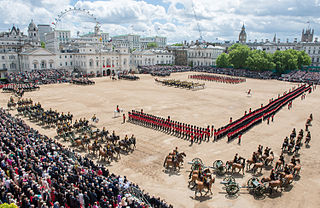
Trooping the Colour is a ceremony performed every year in London, United Kingdom, by regiments of the British Army. Similar events are held in other countries of the Commonwealth. Trooping the Colour has been a tradition of British infantry regiments since the 17th century, and since 1748 has marked the official birthday of the British sovereign, although its roots go back much earlier.
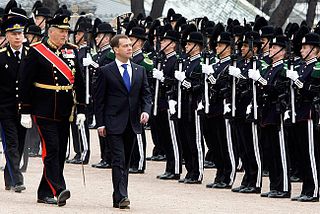
In some militaries, foot guards are senior infantry regiments. Foot guards are commonly responsible for guarding royal families or other state leaders, and they also often perform ceremonial duties accordingly, but at the same time are combat soldiers.

Guard mounting, changing the guard, or the changing of the guard, is a formal ceremony in which sentries performing ceremonial guard duties at important institutions are relieved by a new batch of sentries. The ceremonies are often elaborate and precisely choreographed. They originated with peacetime and battlefield military drills introduced to enhance unit cohesion and effectiveness in the late 17th and early 18th centuries.
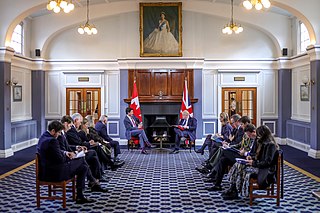
RAF Northolt is a Royal Air Force station in South Ruislip, 2 nautical miles from Uxbridge in the London Borough of Hillingdon, western Greater London, England, approximately 6 mi (10 km) north of Heathrow Airport. The station handles many private civil flights in addition to Air Force flights. Northolt has one runway in operation, spanning 1,687 m × 46 m, with a grooved asphalt surface. This airport is used for government and VIP transport to and from London.

The Royal Air Force Regiment is part of the Royal Air Force and functions as a specialist corps. Founded by royal warrant in 1942, the Corps carries out soldiering tasks relating to the delivery of air power. Examples of such tasks are non-combatant evacuation operation (NEO), recovery of downed aircrew, and in-depth defence of airfields by way of aggressively patrolling and actively seeking out infiltrators in a large area surrounding airfields. In addition the RAF Regiment provides Joint Terminal Attack Controllers (JTACs) to the British Army and Royal Marines, and provides flight size commitment to the Special Forces Support Group.
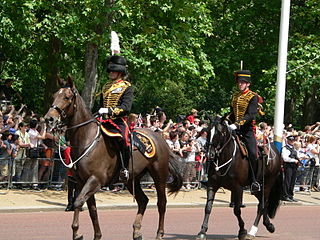
The King's Troop, Royal Horse Artillery, is a ceremonial unit of the British Army, quartered at Woolwich. It is a mounted unit and all of its soldiers are trained to care for and drive teams of six horses, each team pulling a First World War-era QF 13-pounder gun; six teams are used in the unit's Musical Drive. The Troop's duties include firing salutes on royal and state occasions, participation in parades, and the duties of the King's Life Guard at Horse Guards for one month each year. The unit provides the gun carriage and team of black horses for state funerals. The unit is most often seen providing gun salutes on state occasions in Hyde Park, and Green Park.

Australia's Federation Guard (AFG) is a tri-service ceremonial unit made up of members from the Royal Australian Navy, Australian Army, and Royal Australian Air Force. Formed in 2000 for the centenary celebrations of Australian federation, it is the first purely ceremonial unit in the history of the Australian armed forces, and has since represented Australia in various roles both at home and around the world, including providing the guard at Buckingham Palace in 2000.
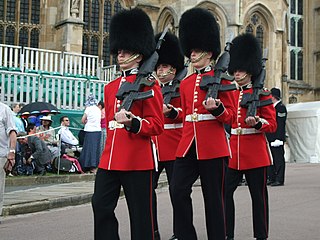
The King's Guard and King's Life Guard are the contingents of infantry and cavalry soldiers charged with guarding the official royal residences in the United Kingdom. The King's Guard are infantry contingents, while the King's Life Guards are cavalry troopers.

In military organizations, the practice of carrying colours, standards, flags, or guidons, both to act as a rallying point for troops and to mark the location of the commander, is thought to have originated in Ancient Egypt some 5,000 years ago. The Roman Empire also made battle standards a part of their vast armies. It was formalized in the armies of Europe in the High Middle Ages, with standards being emblazoned with the commander's coat of arms.
An equerry is an officer of honour. Historically, it was a senior attendant with responsibilities for the horses of a person of rank. In contemporary use, it is a personal attendant, usually upon a sovereign, a member of a royal family, or a national representative. The role is equivalent to an aide-de-camp, but the term is now prevalent only in the Commonwealth of Nations.

Beating Retreat is a military ceremony dating to 17th-century England and was first used to recall nearby patrolling units to their castle.

Public duties are performed by military personnel, and usually have a ceremonial or historic significance rather than an overtly operational role.

The Household Cavalry Mounted Regiment (HCMR) is a cavalry regiment of the British Army tasked primarily with ceremonial duties. Part of the Household Division, it is classed as a regiment of guards, and carries out mounted ceremonial duties on State and Royal occasions. The HCMR is one of two operational units that form the Household Cavalry (HCav), the other being the Household Cavalry Regiment (HCR), a formation reconnaissance regiment, with front-line combat duties.

A guard of honour (GB), also honor guard (US), also ceremonial guard, is a group of people, usually military in nature, appointed to receive or guard a head of state or other dignitaries, the fallen in war, or to attend at state ceremonials, especially funerals. In military weddings, especially those of commissioned officers, a guard, composed usually of service members of the same branch, form the Saber arch. In principle any military unit could act as a guard of honour. However, in some countries certain units are specially designated to serve as a guard of honour, as well as other public duties.

The Royal Auxiliary Air Force (RAuxAF), formerly the Auxiliary Air Force (AAF), together with the Air Force Reserve, is a component of His Majesty's Reserve Air Forces. It provides a primary reinforcement capability for the regular service, and consists of paid volunteers who give up some of their weekends, evenings and holidays to train at one of a number of squadrons around the United Kingdom. Its current mission is to provide trained personnel in support of the regular RAF.

A flypast is a ceremonial or honorific flight by an aircraft or group of aircraft. The term flypast is used in the United Kingdom and the Commonwealth. In the United States, the terms flyover and flyby are used.
The Thai Royal Guards parade, also known as Trooping the Colour, occurs every December 2 since 1953, in celebration of the birthday of the King of Thailand, during which the King's Guard of the Royal Thai Armed Forces perform a military parade and pledge loyalty to the monarch. The venue is the Royal Plaza at Bangkok, Thailand, in front of the Dusit Palace and its Ananta Samakhom Throne Hall.

The Presentation of Colours is a ceremony that marks an anniversary or event in the history of a particular regiment. This involves the presentation of a new version of the regimental colour to a regiment or equivalent formation in the armed forces. This is a traditional ceremony that was pioneered by the British Armed Forces, and is today used in most Commonwealth countries.

The 2022 Trooping the Colour ceremony was held on Thursday 2 June 2022, as part of the Platinum Jubilee celebrations of Queen Elizabeth II. Over 1,400 parading soldiers, 200 horses and 400 musicians came together in the traditional parade to mark the Queen's Official Birthday, which usually takes place on the second Saturday of June.




















